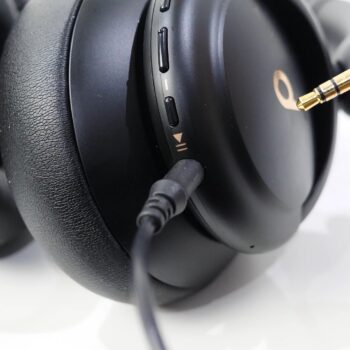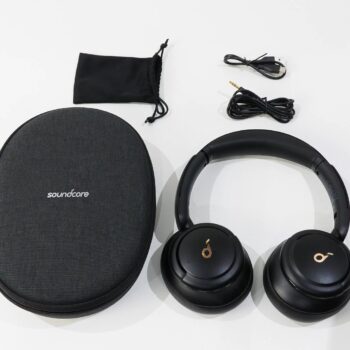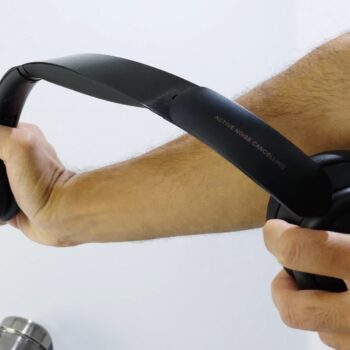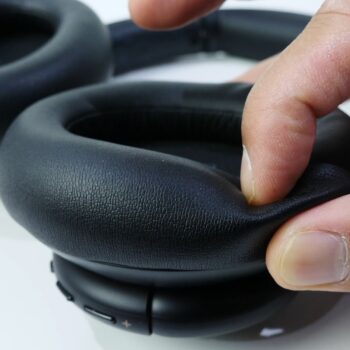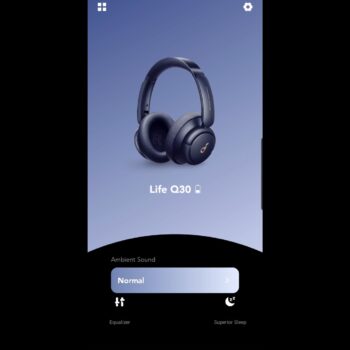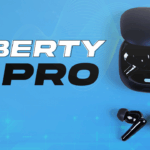The Soundcore Life Q30 are over the ear, noise canceling budget friendly headphones.
Price
In Canada they’re $110 whereas in the United States the price is $80. And despite the low-price tag, it has some cool things going for it.
Connectivity
One of the cool features is that it surprisingly supports a wired and wireless connection. The wired connection uses a 3.5mm auxiliary cable. Both ends of the cable are 3.5mm. The connection to the headphones themselves for the auxiliary connects into the bottom of the right earcup.
In case you’re wondering, yes you can use the headphones while the battery is dead using the wired auxiliary cable, although you cannot use them while they are charging for wireless connectivity.
It uses Bluetooth 5.0, which is a little on the older side but not concerned here since the connection stability is pretty good. In fact, according to Soundcore’s manual, it says that you can get about 49 feet of wireless range on these. I was able to get closer to about 35 feet by having my wireless source connected on the main level in my house as I walked around the basement. With one ceiling in between, I was able to obtain that 35 feet.
It does support dual connectivity. If you have a computer connected as one device and a cell phone as another. While listening to content on the computer, when the cell phone rings, it’ll pause the computer audio and then automatically allow you to answer the phone.
Regarding how many devices you can keep in memory before having to pair them all over again. I couldn’t find anything in the documentation or their website, but in my testing I was able to get four devices in memory, which is pretty good.
The last item for connectivity is support for NFC fast wireless pairing. For example, if you have an Android device that does support an NFC Chip, you can just simply tap, and it’ll connect and pair quickly.
Accessories
I’m very pleased to write, but also surprised that there is a hard traveling case included in the box despite the low-price tag.
Also included in the box is an auxiliary cable, which is measuring roughly 50 inches. Another cable included is a USB-C to USB-A cable. Unfortunately, it’s not pure USB-C and that cable measures about 12 inches.
There’s no power adapter including the box, but that’s typical for most headphone manufacturers. To recharge it, you’ll need to connect it directly to a computer USB port (which is what I do) or use a power adapter from a different device such as your cellphone.
Design & Comfort
The Q30 appearance is well done as it retains a single color throughout most of the design, with the shade off color in the headband. Even with the slightly off color on the headphone compared to the rest of the body, despite some of the visible contours in the frame, and small buttons that are also visible, the Soundcore logo being a standout color gives the design a nice touch, in my opinion.
The Q30 that I reviewed is the black model but it’s also available in Midnight Blue and Sakura Pink.
The body does have a folding design which typically in most cases makes the body a little weak in the frame. Except here, despite the price tag, it’s well constructed and strong. Thanks to that is probably because it weighs 265 grams. A decent amount of material was used to construct the body.
I highly doubt they’re dust and water resistant for two reasons. One is that the water resistance devices listed on the Soundcore website, the Q30 is not there. Also, under the operations section of the Q30 product page are instructions on how to dry them safely if it does encounter any liquid whatsoever.
They’re very comfortable to wear for several hours in a row. Yes, several hours in one session as I would wear them for about four and a half hours straight and my ears never got irritated, hot or sweaty. Even when testing them with glasses, they’re still very comfortable to wear. I never felt any irritation with the frame poking into my head.
If you plan to use them for working out, it’s completely up to you. I mean, they’re budget friendly headphones, but I don’t recommend it because, well, they’re over your headphones. You’re going to sweat a lot. They’re not going be very comfortable even in a short workout. I personally recommend that you avoid it, but it’s up to you.
Going back to how comfort is achieved, the first thing is the headband as it’s not too tight. Of course, helping with that comfort is the soft cushioning of the earcups. On the topic of cushioning, the headband cushioning is extremely thick. Surprisingly at this budget, no material was spared as the headband is very soft for people with next to no hair or well, probably no hair at all.
The headband adjustment is done in notches and the earcups can pivot up, down, forward, and back. It’s very versatile so it can be used on a variety of head shapes and ear shapes.
Surprisingly, if you’re looking for official earcup replacements, you can buy them from the Soundcore website. With that said, you can also buy them from third party vendors as well.
When resting on your neck you turn your head to look left and right, it’s not that comfortable (same with looking down) because the ear cups are too big and a little narrow around my neck. But if you were to fold the earcups down, looking left and right is much easier, as well as looking down. While the earcups are still folded down, it doesn’t dig into my neck either.
Controls
Switching over to controls on the left earcup is a button for turning the Q30 on and off, and holding this button also activates Bluetooth pairing mode.
There’s another button for ANC (active noise canceling) and pressing this button will cycle to transparency mode, which allows you to hear your surroundings by capturing that noise into the microphone and projecting it into the earcups so you can hear them easily in the earcups. Another mode to cycle to is regular headphone mode.
Even though there is a physical ANC toggle button, if you touch and hold the side of the right earcup for 2 seconds it’ll switch between ANC modes. The problem here is that it’s annoying when you’re picking up or putting down the headphones, I notice that you naturally touch the earcup and it’ll switch to ANC mode, normal mode, or transparency mode. It’s annoying and you can’t even turn it off in the app, in fact there’s no function to turn off that touch control. It’s annoying and redundant because you have a physical button that does the job just the same. The physical button is better because it doesn’t switch accidentally to a different listening mode.
Over to the right earcup, there’s a button for play/pause music, which is also used to answer or hang up a call. Holding that same button will activate the smart assistant of your device. My testing was done with Google assistant with Android, and it worked well.
There is of course a button to increase volume, holding it will go to the next track and a button for volume down, which holding it will go to the previous track. For some bizarre reason, the play/pause button is placed lower than the volume down button. The play/pause is on its own and not between volume up and volume down. Frequently when I’m wanting to repeat a track I like, I’ll want to press and hold the volume down button thinking it’ll go the beginning of the track, except I end up pressing play/pause. The button placement is poorly done.
There’s no side tone available, which isn’t surprising at this price budget. That feature would have been activated while on a phone call to project the noise into the earcups kind of like transparency mode, except you can hear what it’s like for the other person on the other end of your call. So, if it’s a noisy environment, you’re more likely to hear what they’re going to hear. You can also hear your own voice if maybe you’re talking too loud or too softly. It’s unfortunate that the feature isn’t available, but not a big deal.
Another feature that’s not available but not surprising at this price point is auto play/pause. When you have the headphones on with content playing it’s normal, when you take off the headphones it’ll automatically pause, put them back on and the content will resume. This feature is not available, but again not surprising, or disappointing at this price point.
Noise Cancelling
Active noise canceling (ANC) performs pretty good at this budget. Low frequency sounds like, say the engine of a bus or a car, it’ll do well to cancel out most of it.
Again, these are budget friendly. don’t expect the best performance. If want to take it on a plane it can perform just okay. The engine noise from the plane, you know the turbine thing on the flap of the wing… As you can tell, I don’t know plane parts. What I’m trying to say is that the plane engine noise will come through and you’ll have to blast the volume quite a bit to hear what’s being said. Especially if you’re listening to a podcast.
In a situation such as being on a bus, the engine will be suppressed significantly. But you have the opposite problem where you have a lot of vocals and a lot of people talking potentially on public transportation. Noise from vocals comes through quite a bit. That’s not surprising for budget friendly headphones. But let’s make one thing clear, can you use this on public transportation with a lot of people talking for listening to podcasts or news? Yes. Again, if you crank up the volume quite a bit then you can hear your content fine.
Transparency mode, to hear your surroundings performed a lot better than anticipated. To be honest, I’m really impressed. I can hear things well from anything about 15 feet away. It performs better than most headphones that are mid-tier price or almost double the price, really surprised. The sound is clear enough to keep the headphones on and make conversation if your audio is paused.
Here’s a weird thing about these headphones. They’re over the ear and the earcup cushioning is rather thick. Now you would think that when you switch to regular headphone mode (ANC and no transparency mode), just simple headphone mode, you would think that naturally a lot of noise would be suppressed from the cushioning itself, except it doesn’t. Low frequency sounds like the engine noise of a car, it’ll cancel a bit. However, vocals come through very easily, it’s very bizarre. I’ve sat in a room with people just talking to one another, not too loud, and I can hear everything. I can make out exactly what they’re saying. Of course, it’s not crystal clear and a tad bit muffled, but I can tell exactly what they’re saying. Is that a concern? Not really. You would usually want regular headphone mode to conserve battery to make it last longer. However, the battery performance isn’t a concern. You’re probably never going to need regular headphone mode. Which brings us to the next point… Battery.
Battery
Soundcore claims at about 60% volume for ANC and transparency mode, each type of technology usage will average about 40 hours of battery usage. In my testing at 50% volume (instead of 60% like Soundcore) I average for ANC and transparency mode 55 hours, which is incredible.
That’s not the surprising part. The surprising part really is regular headphone mode. Again, with Soundcore claim at 60% volume with no ANC or transparency mode, they get about 60 hours of battery usage. In my testing I got 80.5 hours at 50% volume. I’m not kidding you. It took me forever to drain the battery on this and that’s what I achieved.
Soundcore claims it’ll take about 2 hours to recharge these headphones, but in my testing, connecting directly to a computer, I average closer to an hour and 40 minutes.
Incredible battery performance for quick recharge time. You’ll probably be hard pressed to ever drain these.
The USB-C charging port is located on the bottom of the left earcup.
Microphone Quality
While using the microphone for a phone call in a quiet environment, the quality isn’t bad given the price. The best way to describe the quality is by comparing it to a laptop microphone. Although it sounds a tad bit more muffled compared to most good quality laptop microphones. It’s not bad but that’s the best way for me to describe it if you don’t watch the video review above.
While replicating a noisy restaurant, it does well at removing most of the background noise but of course not entirely. It’s enough to easily have a conversation but some of the background noise will come through as quite muffled noise.
Lastly, while replicating a windy environment it struggled a bit. A lot of the wind noise comes through the microphone, making it a bit annoying for the person on the other end to have a conversation with you. They can hear what you’re saying if you talk a bit loud, so your voice isn’t drowned out by the wind noise.
Audio Quality
In terms of audio quality codecs, it supports SBC and AAC but no aptX, which shouldn’t be surprising because again, it supports Bluetooth 5.0. Going back to the connection stability, I don’t really notice any latency issues with my computer or cell phone. The audio has performed well. Despite being Bluetooth 5.0, there’s no real concern here and again, they’re budget friendly headphones.
General audio quality out of the box, it performs well at this price point. There’s a lot more focus on bass, which I’m not complaining about, I’m a bass enthusiast. But for those of you that weren’t expecting bass performance out of this, yeah, you’re going get a real big kick. The performance on lows on this is incredible, of course you can just lower it in the app equalizer which I’ll cover shortly.
When it comes to equalizer adjustment to increase bass, it will get rumbling. There are certain songs that just perform amazingly with these headphones and surprising how cheap these are, especially songs like Last Memory by Take Off. The audio performance is incredible. When that bass hits every so often, it’s a joy for me. When the bass kicks in on songs that are bass centric focused, it doesn’t distort or warp the audio, it always sounds crystal clear. Here’s the weird thing, songs that are not bass focused and you increase bass up, it kind of makes the audio vocals muffled a little bit. Basically, songs with minimal bass, when the person who’s singing or rapping, you’ll notice the quality goes down on the vocals ever so slightly.
It’s kind of weird when it comes to vocals and when it’s increased. It’s strange because vocals will stand out, they sound clear, they’re not ruined, but the rest of the sound sounds a little warped. It’s not going to ruin the song entirely, but you will notice that the song kind of degrades ever so slightly in all other areas except for vocals.
When it comes to increasing highs, no concerns here. It gets sharp, there’s no distortion to the rest of the audio performance, it’s fantastic.
What about sound quality when wearing glasses? Vocals and highs whether it’s out of the box or increasing it in the app sounds okay, it’s not bad. The problem here is bass. It doesn’t matter if it’s out of the box or increased in the app, you will lose a lot of performance on the bass. This is a typical thing with almost every headphone I review because the glasses frame will poke out of the cushioning and that’s where a lot of the bass leaks out. It doesn’t ruin any songs but for those who are bass enthusiasts, you’re not going to want to get these headphones or probably any over the ear headphones for that matter.
Software
The last thing to cover is the app. It’s very minimalistic, but it gets the job done given the price point. So, let’s dive into it. The first thing to see is ambient sound which allows to choose from normal that’s regular headphone mode), transparency mode, and noise cancellation mode.
Next is the equaliser. You have a custom equaliser which you can adjust accordingly as you wish to. You can also save your created profiles here. There’s also default sound signatures, which are just pre-made templates. You can go through various ones if you want to and choose that if that’s more to your liking.
The next section is Superior Sleep. What it’ll do is play some ambient type of noise in the background. Some of these include noise of rainfall, birds chirping, and campfire sounds. It’s a simple but cool feature. I personally don’t use it, but I can see how a lot of people would like to have that built in.
And of course, going to the main system settings menu on the top right, there’s not much here except the most important thing arguably is firmware updates. There’s a quick start guide, which is kind of like a built-in manual and that’s pretty much it.
The app is simple but effective.
Conclusion
The Q30 is a tough contender when it comes to budget friendly headphones, although it does have some weird nuances. It’s nothing that’s going to ruin the product by any means. It’s still something you would want to consider.
For bass performance it’s a solid option at a budget friendly price point.
Again, like I wrote you can take it on various transportation means, whether it be public transportation or in a plane. Of course, in very noisy settings such as being on a plane, you’ll just need to increase the volume of your content quite a bit.
Score:
8/10
-Price for performance
-Auxiliary connection
-Bluetooth range
-Dual connect
-Multi-device memory
-Hard carrying case
-Decent appearance
-Build strength
-Comfortable
-Colour options
-Official replacement cushions
-ANC performance
-Transparency performance
-Battery
-USB-C charging port
-Microphone quiet setting
-Okay noise cancelling microphone
-Decent audio quality
-App
Cons:
-USB-A to USB-C cable
-Microphone windy setting
-ANC touch control
-Play/pause button placement
-Bass performance on songs with little bass
-EQ vocals warps audio


